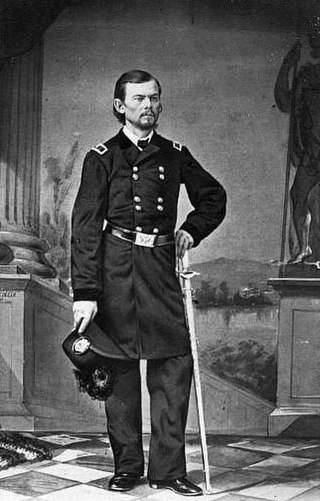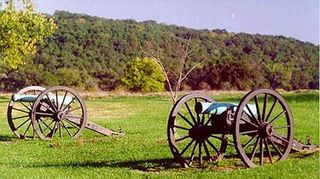
The Battle of Wilson's Creek, also known as the Battle of Oak Hills, was the first major battle of the Trans-Mississippi Theater of the American Civil War. It was fought on August 10, 1861, near Springfield, Missouri.

Nathaniel Lyon was a United States Army officer who was the first Union general to be killed in the American Civil War. He is noted for his actions in Missouri in 1861, at the beginning of the conflict, to forestall secret secessionist plans of the governor Claiborne Jackson.

Claiborne Fox Jackson was an American politician of the Democratic Party in Missouri. He was elected as the 15th Governor of Missouri, serving from January 3, 1861, until July 31, 1861, when he was forced out by the Unionist majority in the Missouri General Assembly after planning to force the secession of the state.

The Camp Jackson affair, also known as the Camp Jackson massacre, occurred during the American Civil War on May 10, 1861, when a volunteer Union Army regiment captured a unit of secessionists at Camp Jackson, outside the city of St. Louis, in the divided slave state of Missouri.
During the lead-up to the American Civil War, the proposed secession of Missouri from the Union was controversial because of the state's disputed status. The Missouri state convention voted in March 1861, by 98-1, against secession, and was a border state until abolishing slavery in January 1865. Missouri was claimed by both the Union and the Confederacy, had two rival state governments,, and sent representatives to both the United States Congress and the Confederate Congress.

Franz Sigel was a German American military officer, revolutionary and immigrant to the United States who was a teacher, newspaperman, politician, and served as a Union major general in the American Civil War. His ability to recruit German-speaking immigrants to the Union armies received the approval of President Abraham Lincoln, but he was strongly disliked by General-in-Chief Henry Halleck.
The Battle of Dry Wood Creek, also known as the Battle of the Mules, was fought on September 2, 1861, in Vernon County, Missouri, during the American Civil War. After his victory at the Battle of Wilson's Creek on August 10, Sterling Price and the Missouri State Guard moved further north into Missouri. A force of Union troops under James H. Lane moved from Fort Scott, Kansas to attempt an interception of Price's army, and set an ambush along Dry Wood Creek. Price's Missouri State Guard troops outnumbered Lane's Kansas troops, and after a two hour skirmish forced Lane to retreat to Fort Scott. In their retreat, Lane's troops abandoned their supplies and mules to the Missourians. Price followed up his victory by continuing his northward march, culminating in another victory at the siege of Lexington, September 13 to 20, before returning south shortly afterwards.

The First Battle of Boonville was a minor skirmish of the American Civil War, occurring on June 17, 1861, near Boonville in Cooper County, Missouri. Although casualties were extremely light, the battle's strategic impact was far greater than one might assume from its limited nature. The Union victory established what would become an unbroken Federal control of the Missouri River, and helped to thwart efforts to bring Missouri into the Confederacy.
The Battle of Roan's Tan Yard, also known as the Battle of Silver Creek, was a minor battle fought during the American Civil War on January 8, 1862, in Randolph County, Missouri. After back-and-forth operations throughout 1861, the pro-Confederate Missouri State Guard under the command of Sterling Price had been confined to southwestern Missouri. In December 1861, Price authorized recruiting and raiding activities in the central portion of the state, with the North Missouri Railroad being a major target. In January 1862, Major W. M. G. Torrence of the Union Army located a Missouri State Guard base in Randolph County and attacked it on January 8 with elements of four cavalry regiments. The camp, which was commanded by Colonel John A. Poindexter, put up little resistance and was soon overrun. Large quantities of supplies were captured in the abandoned camp, which was destroyed. The action at Roan's Tan Yard, along with a Missouri State Guard defeat at the Battle of Mount Zion Church the preceding December, led to a decrease in pro-Confederate activity in central Missouri.

The St. Louis Arsenal is a large complex of federal military weapons and ammunition storage buildings operated by the United States Air Force in St. Louis, Missouri. During the American Civil War, the St. Louis arsenal's contents were transferred to Illinois by Union Captain Nathaniel Lyon, an act that helped fuel tension between secessionists and those citizens loyal to the Federal government.
The Price–Harney Truce was a document signed on May 21, 1861, between United States Army General William S. Harney and Missouri State Guard commander Sterling Price at the beginning of the American Civil War.

The Missouri State Guard (MSG) was a military force established by the Missouri General Assembly on May 11, 1861. While not a formation of the Confederate States Army, the Missouri State Guard fought alongside Confederate troops and, at various times, served under Confederate officers.

Wilson's Creek National Battlefield, located near Republic, Missouri, preserves the site of the Battle of Wilson's Creek. Fought on August 10, 1861, the battle was the first major American Civil War engagement west of the Mississippi River. In the battle, a Confederate army commanded by Benjamin McCulloch and Sterling Price defeated a smaller Union army commanded by Nathaniel Lyon. However, the Confederates were unable to hold much of Missouri, and a Confederate defeat at the Battle of Pea Ridge effectively solidified Union control of the state. Major features include a five-mile automobile tour loop, the restored 1852 Ray House, and "Bloody Hill", the site of the final stage of the battle. The site is located near Republic in southwestern Missouri just southwest of the city of Springfield. It has been a unit of the National Park Service since 1960, and was listed on the National Register of Historic Places in 1966.

During the American Civil War, Missouri was a hotly contested border state populated by both Union and Confederate sympathizers. It sent armies, generals, and supplies to both sides, maintained dual governments, and endured a bloody neighbor-against-neighbor intrastate war within the larger national war.
The 2nd Missouri Infantry Regiment was an infantry regiment, formed from a voluntary regiment using the same name, that served in the Union Army during the American Civil War.

The 1st Missouri Infantry Regiment evolved from one of several unofficial pro-Unionist Home Guards militia formed in St. Louis in the early months of 1861 by Congressman Francis Preston Blair Jr. and other Unionist activists. The militia that would become the First Missouri was largely composed of ethnic Germans, although Companies K and I had significant numbers of native born American citizens and Irish-Americans. Although initially without any official standing, beginning on April 22, 1861, the four "underground" militia regiments Blair helped organize were sworn into Federal service at the St. Louis Arsenal by Captain John Schofield acting on the authority of President Lincoln.

The Minutemen was a secessionist paramilitary organization in St. Louis, Missouri in the early months of 1861. Many members joined the 2nd Regiment of the Missouri Volunteer Militia, and after May 10, 1861 the Missouri State Guard or the Confederate States Army.

The 3rd Missouri Infantry Regiment was an infantry regiment that served in the Union Army during the American Civil War. It arose from a group of volunteers who were active from April to September 1861.
The 5th Missouri Infantry Regiment evolved from a network of several unofficial pro-Unionist militia groups formed semi-secretly in St. Louis in the early months of 1861 by Congressman Francis Preston Blair Jr. and other Unionist activists. The Fifth Missouri was largely composed of ethnic Germans, who were generally opposed to slavery and strongly supportive of the Unionist cause. Although initially without any official standing, beginning on April 22, 1861, the militia regiments Blair helped organize were sworn into Federal service at the St. Louis Arsenal by Captain John Schofield acting on the authority of President Lincoln.

The 3rd Missouri US Reserve Corps Infantry Regiment evolved from one of several unofficial pro-Unionist militia units formed semi-secretly in St. Louis in the early months of 1861 by Congressman Francis Preston Blair Jr. and other Unionist activists. The organization that would become the Third U.S.R.C was largely composed of ethnic Germans, who were generally opposed to slavery and strongly supportive of the Unionist cause. 20 percent of the men of the regiment were "native" U.S. citizens. Although initially without any official standing, beginning on April 22, 1861, the Unionist regiments Blair helped organize were sworn into Federal service at the St. Louis Arsenal by Captain John Schofield acting on the authority of President Lincoln.
















